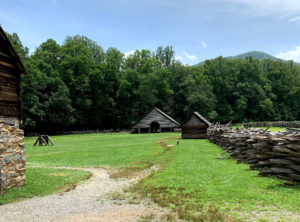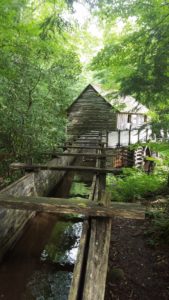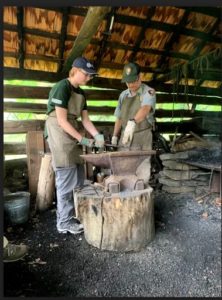The GSMNP high school summer interns learned about life for those who lived in the Great Smoky Mountains in the 1800s by visiting Cades Cove and the Mountain Farm Museum in Oconaluftee. Anna Wright shares some of what the interns learned.

by Anna Wright
Pigeon Forge High School graduate
Pigeon Forge, Tennessee
Attending University of Tennessee/Knoxville
The Great Smoky Mountains are known for lush forests, scenic views, and loads of wildlife.
An equally wonderful part is the cultural past of the park.
We had the opportunity to visit both Cable Mill area in Cades Cove and the Mountain Farm Museum in Oconaluftee to learn about the history of the area.
[At the top of this post is a photo of the Tennessee high school interns during their visit to Cades Cove.]
Historical Parts of the Park

The history of humans in the park can be traced back thousands of years, beginning with the Cherokee who inhabited the region.
European settlers began to take root in the 1800s. More than 90 historic structures from those settlers are in the park, including houses, barns, outbuildings, churches, schools and grist mills.
A small community usually had a grist mill where you would trade some of your harvest for the owner to grind your corn into meal. Settlers also had sourgum mills, corn cribs and barns.
With a visit to the Cable Mill Visitor’s Center in Cades Coves and the Mountain Farm Museum at Oconaluftee, we got an inside peek the life an early settler would live.
Blacksmithing
Living in the mountains in the 1800s was rough.
Blacksmithing was an important skill. Blacksmithing was an important skill to have to make and repair tools.
Usually one person in a family would know blacksmithing.
The reason a blacksmith is called such is that they work with black metal.
That fact was just one thing I learned on a trip to Cades Cove to learn how to blacksmith.

In blacksmithing, you heat the metal until it turns a yellow-orange color, then you can bend or hammer it into the desired shape.
Common things created were nails and kitchenware. We had the chance to make dinner bells, another useful tool of the time period.
Reflection
Before this internship, I always thought of nature when I thought of the Great Smoky Mountains National Park.
Through the high school summer internship program, I have developed an appreciation for the historic buildings in the park because they preserve the past.
The park’s mission is to protect and preserve.
Seeing the maintenance crew work to keep the buildings strong and seeing the interpretation rangers educate people on how people use to live opened my eyes to a lesser-known part of the Great Smoky Mountain National Park.
I plan to go into a wildlife health career and always wanted to work in nature.
Nonetheless, the cultural part of the park and how it can connect people to the past is one of my favorite things.
***
FOTS supports GSMNP internship program
For six weeks, the interns worked with rangers, Teachers in the Parks and volunteers on projects in the park to learn more about GSMNP and to get a feel of what being a park ranger is like.
Sixteen students from North Carolina and Tennessee participated in the program this summer.
Friends of the Smokies has helped support the GSMNP High School Internship Program for 17 years, initially providing the salaries for the interns and then helping fund the program staff salaries. The program is funded in part by the American Conservation Experience (ACE).
Several of this summer’s interns have written guest posts and compiled photos of their experiences for the FOTS blog. All the photos in this post were taken by the Tennessee interns.
A special thanks to Ranger Jessica Snow, who coordinated the Tennessee interns, and Ranger Erin Lamm, who coordinated the North Carolina interns, for their assistance with the interns’ blog posts.
You can support the GSMNP high school summer internship program or support other education programs that FOTS funds, including Teachers in Parks, Parks as Classrooms, the Kathryn McNeill Endowment that funds an education specialist, and the Park Liaison program at the Cherokee School.

